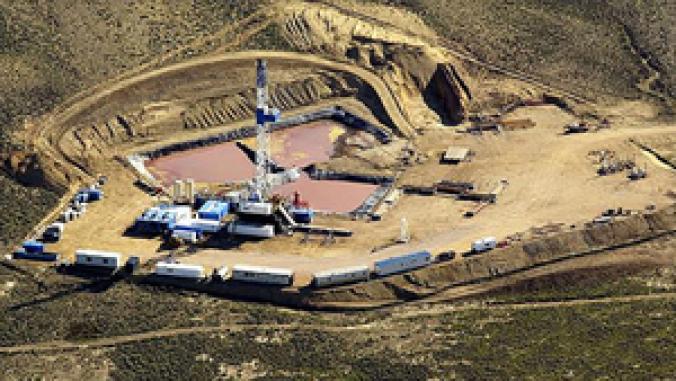When 9 Miles per Gallon is a Step in the Right Direction
<p>The EPA's proposed new mileage standards for semi-trucks -- all the way up to 9 mpg -- would actually represent a huge leap forward for fuel efficiency and for the environment.</p>

When does 9 miles a gallon sound just dandy -- environmentally and businesswise -- to a longtime sustainability stalwart like me?
No, it's not because I've sold out and traded my Camry hybrid for a fire-sale Escalade.
We're talking trucks here -- those big, hulking semis filling your rearview mirror on the interstate plus their smaller cousins, right on down to delivery vans.
Here's the deal: The Environmental Protection Agency and National Highway Traffic Safety Administration are considering new mileage standards for that fleet -- which burns up 20 percent of America's transportation fuel and emits the same share of the country's carbon pollution.
Right now heavy-duty trucks -- a huge part of the way we move products around in this country -- are clocking just 6 miles per gallon. And the technology is there -- the Union of Concerned Scientists describes it as "existing and near term" -- to move that number by a lot. Maybe even to 9 mpg.
And if the entire fleet right down to delivery vans could move to just a 9.7 mpg average, UCS says that would save 100 billion gallons of diesel over the next two decades, topping out at 11 billion gallons in 2030 alone.
Still hung up on that single-digit number? Let me put it this way: Wouldn't you gladly embrace a 50 percent increase in fuel efficiency, with its commensurately smaller carbon footprint, in any other sector of the economy?
I would, in a heartbeat.
So it's time -- during the official public comment period going on right now -- to send the EPA and NHTSA a message: Go for that high-end single digit.
And not just because it's good for the environment -- it also makes all kinds of good business, economic and competitiveness sense.
Let's start with the pure business argument, and it's simple: Does free sound attractive?
Because that's what a conversion to higher-mileage trucks would cost -- exactly nothing over a typical ownership period. In fact you'd actually make money. The thousands of gallons in per-truck fuel savings will more than pay for the higher costs of a more efficient engine, according to a CALSTART study.
Now let's move to the macro-economic. UCS and CALSTART say those benefits will also accrue to the wider economy, since as truck operating costs come down business owners and consumers reap savings they can invest in more goods and services -- most all of them in America, as opposed to where our fuel money goes.
Competitiveness? Here's news worth knowing: The U.S. is a global leader in efficient truck engine development and manufacturing. So stricter standards will expand the global market for that domestic product while providing the certainty that catalyzes investment in those technologies. According to CALSTART, the 15,000 U.S. jobs now directly tied to hybrid and high-efficiency truck technology can grow, in just the coming decade, to more than 55,000 with appropriate policies.
Then there are the national security arguments tied to our vulnerability to rising fuel prices, and the fact that more and more companies will likely join a growing trend toward public disclosure of their emissions. That second one is a potential reputational risk for laggards -- or a public relations boon for those who choose to get out front.
So what's standing in the way of all this common sense?
It turns out industry isn't opposed to the moderate new standards now on the table, but most say they can't meet stronger, and feasible average 9 mpg standards. And we're hearing one version of a very old refrain when situations like this arise: It's going to be hard to meet even modestly stricter goals.
History says those kinds of vested-interest concerns almost never hold water. Time and again, higher standards from government actually stimulated economic growth, America's competitiveness, and put cost worries to rest. For instance the federal Clean Air Act of 1970 spurred the creation of a burgeoning air pollution control equipment industry, which generated revenues of $18.3 billion in 2007 (including more than $3 billion in exports) and is part of a broader U.S. environmental technologies industry that had $282 billion in revenue in 2007 and employs 1.6 million Americans.
Not to mention the avoided costs of all that pollution that didn't happen.
The enduring lesson? The world changes -- it's businesses that don't change with it that are most likely to take a hit, not those that adapt.
So let's make sure the change-resistant don't trump the larger national interest this time.
Somehow, in writing this I can't chase the words of a 1975 novelty song called "Convoy" out of my mind. OK, I'm dating myself. It was a clever ditty that made it pretty far up the pop charts by glamorizing the life of long-distance truckers.
At 9 miles a gallon, we might even bring new meaning to the catchy part of that song's chorus:
"Come on and join our convoy,
Nothin' gonna get in our way.
We're gonna roll this truckin' convoy
'Cross the U-S-A."
Get on the 9 mpg convoy, America. As another line from that old song put it: "Ain't it a beautiful sight?"
Photos CC-licensed by MJM and SoulRider.222.





